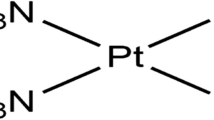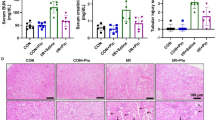Abstract
Remote preconditioning is a unique phenomenon in which brief episodes of ischemia and reperfusion to remote organ protect the target organ against sustained ischemia–reperfusion (I/R)-induced injury. Protective effects of remote renal preconditioning (RRPC) are well established in heart, but their mechanisms still remain to be elucidated. So, the present study was designed to investigate the possible role of oxygen-sensing hypoxia inducible factor-prolyl 4-hydroxylases (HIF-P4Hs) in RRPC-induced cardioprotection in rats. Remote renal preconditioning was performed by four episodes of 5 min renal artery occlusion and reperfusion. Isolated rat hearts were perfused on Langendorff apparatus and were subjected to global ischemia for 30 min followed by 120 min reperfusion. The levels of lactate dehydrogenase (LDH) and creatine kinase (CK) were measured in coronary effluent to assess the degree of myocardial injury. Extent of myocardial infarct size and coronary flow rate was also measured. Ethyl 3,4-dihydroxybenzoate (EDHB) and α-ketoglutarate (α-KG) were employed as HIF-P4Hs inhibitor and activator, respectively. Diethyldithiocarbamic acid (DDCA) was employed as NFkB inhibitor. Remote renal preconditioning prevented I/R-induced myocardial injury and produced cardioprotective effects. Pharmacological preconditioning with EDHB (100 mg kg−1 i.p.) mimicked the cardioprotective effects of RRPC. However, α-KG (200 mg kg−1 i.p.) and DDCA (150 mg kg−1 i.p.) abolished cardioprotective effects of RRPC and EDHB. So, it may be concluded that inhibition of HIF-P4H has a key role in RRPC-induced cardioprotection. Further, remote preconditioning-induced HIF-P4H inhibition may have triggered a transduction pathway involving activation of NFkB.




Similar content being viewed by others
Abbreviations
- HIF-P4Hs:
-
Hypoxia-inducible factor-prolyl 4-hydroxylases
- HIF-α:
-
Hypoxia-inducible factor
- EDHB:
-
Ethyl 3,4-dihydroxybenzoate
- NFkB:
-
Nuclear factor kappa-B
- DDCA:
-
Diethyldithiocarbamic acid
- KH:
-
Kreb’s Henseleit
- TTC:
-
Triphenyl tetrazolium chloride
- LDH:
-
Lactate dehydrogenase
- CK:
-
Creatine kinase
- RRPC:
-
Remote renal preconditioning
- I/R:
-
Ischemia–reperfusion
References
Kharbanda RK, Mortensen UM, White PA et al (2002) Transient limb ischemia induces remote ischemic preconditioning in vivo. Circulation 106:2881–2883
Przyklenk K, Baurer B, Ovize M et al (1993) Regional ischaemic “preconditioning” protects remote virgin myocardium from subsequent sustained coronary occlusion. Circulation 87:893–899
Tokuno S, Hinokiyama K, Tokuno K et al (2002) Spontaneous ischaemic events in the brain and heart adapt the hearts of severely atherosclerotic mice to ischemia. Arterioscler Thromb Vasc Biol 22:995–1001
Patel HH, Moore J, Hsu AK et al (2002) Cardioprotection at a distance: mesenteric artery occlusion protects the myocardium via an opioid sensitive mechanism. J Mol Cell Cardiol 34:1317–1323
Wang YP, Xu H, Mizoguchi et al (2001) Intestinal ischemia induces late preconditioning against myocardial infarction: a role for inducible nitric oxide synthase. Cardiovasc Res 49:391–398
Takaoka A, Nakae I, Mitsunami K et al (1999) Renal ischemia/reperfusion remotely improves myocardial energy metabolism during myocardial ischemia via adenosine receptors in rabbits: effect of remote preconditioning. J Am Coll Cardiol 33:556–564
Singh M, Sharma A (2004) Mechanism of cardioprotective effect of remote aortic preconditioning. In: Dhalla NS, Angel RA, Pierce GN (eds) Pathophysiology of cardiovascular diseases. Kluwer Academic Publishers, Boston, pp 277–285
Xia Z, Herijgers P, Nishida T et al (2003) Remote preconditioning lessens the deterioration of pulmonary function after repeated coronary artery occlusion and reperfusion in sheep. Can J Anaesth 50:481–488
Loukogeorgakis SP, Donald A, Charakida M et al (2005) Remote ischaemic preconditioning provides early and late protection against endothelial ischemia reperfusion injury in humans. J Am Coll Cardiol 46:450–456
Semenza GL (2001) HIF-1, O2, and the 3 PHDs: how animal cells signal hypoxia to the nucleus. Cell 107:1–3
Jaakkola P, Mole DR, Tian YM et al (2001) Targeting of HIF-α to the von Hippel–Lindau ubiquitylation complex by O2 regulated prolyl hydroxylation. Science 292:468–472
Bruick RK, McKnight SL (2001) A conserved family of prolyl 4-hydroxylases that modify HIF. Science 294:1337–1340
Kaelin WG (2005) Proline hydroxylation and gene expression. Annu Rev Biochem 74:115–128
Ockaili R, Natarajan R, Salloum F et al (2005) HIF-1 activation attenuates postischemic myocardial injury: role for heme oxygenase-1 in modulating microvascular chemokine generation. AJP—Heart and Circulatory Physiology 289:H542–H548
Natarajan R, Salloum FN, Fisher BJ et al (2006) Hypoxia inducible factor-1 activation by prolyl 4-hydroxylase-2 gene silencing attenuates myocardial ischemia reperfusion injury. Circ Res 98:133–140
Siddiq A, Ayoub IA, Chavez JC et al (2005) Hypoxia-inducible Factor Prolyl 4-Hydroxylase Inhibition. A target for neuroprotection in the central nervous system. ASBMB 280:41732–41743
Jones NM, Lee EM, Brown TG et al (2006) Hypoxic preconditioning produces differential expression of hypoxia-inducible factor-1alpha (HIF-1alpha) and its regulatory enzyme HIF prolyl hydroxylase 2 in neonatal rat brain. Neurosci Lett 404:72–77
Son ED, Choi GH, Kim H et al (2007) Alpha-ketoglutarate stimulates procollagen production in cultured human dermal fibroblasts and decreases UVB-induced wrinkle formation following topical application on the dorsal skin of hairless mice. Biol Pharm Bull 30:1395–1399
Sasaki T, Majamaa K, Uitto J (1987) Reduction of collagen production in keloid fibroblast cultures by ethyl-3,4-dihydroxybenzoate. Inhibition of prolyl hydroxylase activity as a mechanism of action. J Biol Chem 262:9397–9403
Valen G, Yan ZQ, Hansson GK (2001) Nuclear factor kappa-B and the heart. J Am Coll Cardiol 38:307–314
Kis A, Yellon DM, Baxter GF (2003) Role of nuclear factor-kappa B activation in acute ischemia–reperfusion injury in myocardium. Br J Pharmacol 138:894–900
Xuan YT, Tang XL, Banerjee S et al (1999) Nuclear factor KB plays an essential role in the late phase of ischemic preconditioning in conscious rabbits. Circ Res 84:1095–1099
Cummins EP, Berra E, Comerford KM et al (2006) Prolyl hydroxylase-1 negatively regulates IκB kinase-β, giving insight into hypoxia-induced NFκB activity. PNAS 103:18154–18159
Langendorff O (1885) Untersuchungen amuber lebenderer saugethierherzen. Pfluger Arch Gesmate Physiol 61:291–332
Klein HH, Pushman S, Schaper J et al (1981) The mechanism of the tetrazolium reaction in identifying experimental infarction. Virchows Arch 393:287–297
King JA (1959) A routine method for estimation of lactate dehydrogenase activity. J Med Lab Tech 16:265–272
Swanson JR, Wilkinson JH (1972) Measurements of creatine kinase in serum. Stand Methds Clin Chem 7:33
Belaïdi E, Béguin PC, Ribuot C et al (2006) Hypoxic preconditioning: role of transcription factor HIF-1alpha. Ann Cardiol Angeiol 55:70–73
Bernhardt WM, Câmpean V, Kany S et al (2006) Preconditional activation of hypoxia-inducible factors ameliorates ischemic acute renal failure. J Am Soc Nephrol 17:1970–1978
Li G, Labruto F, Sirsjo A et al (2004) Myocardial protection by remote preconditioning: the role of nuclear factor kappa-B p105 and inducible nitric oxide synthase. Eur J Cardiothorac Surg 26:968–973
Acknowledgments
The authors are grateful to Dr. Ashok Kumar Tiwary, Head, Department of Pharmaceutical Sciences and Drug Research, Punjabi University, Patiala, India for supporting this study and providing technical facilities for the work.
Author information
Authors and Affiliations
Corresponding author
Rights and permissions
About this article
Cite this article
Kant, R., Diwan, V., Jaggi, A.S. et al. Remote renal preconditioning-induced cardioprotection: a key role of hypoxia inducible factor-prolyl 4-hydroxylases. Mol Cell Biochem 312, 25–31 (2008). https://doi.org/10.1007/s11010-008-9717-5
Received:
Accepted:
Published:
Issue Date:
DOI: https://doi.org/10.1007/s11010-008-9717-5




